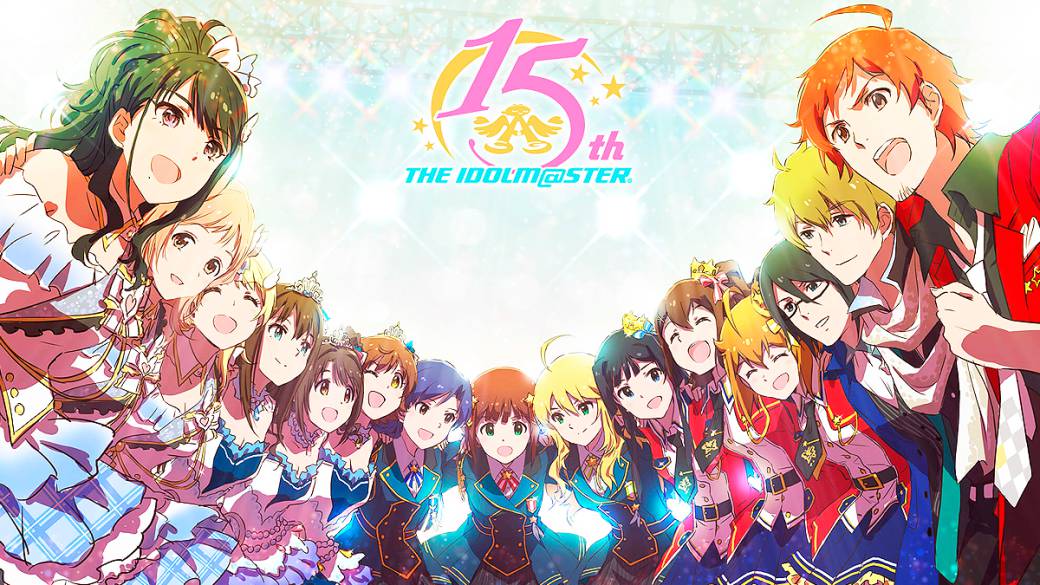
On the occasion of the 15th anniversary of this Bandai Namco franchise, we will review the origins and evolution of the series through its different games.
The Idolmaster series has been one of the franchises that has gained great popularity and acceptance through its different titles. Its success has made it one of Bandai Namco’s flagship franchises to the point of including elements of it in other games such as Ace Combat 6 with various aircraft skins that included the image of each of its protagonists or in different installments of the Tales of series with extra costumes and musical themes from the series.
In turn, it caused the appearance of several titles, both sequels and spin offs, for different platforms, in addition to generating a large amount of merchandising, live concerts of the dubbing actresses, adaptations to manga and anime formats, including in the latter case several series, OVAs and even a movie, and an extensive number of albums that compile the different songs sung throughout each of the games and series. To mark the 15th anniversary of the series and with the future release of the new installment of the series, Starlit Season, we will review some of the games that the franchise has displayed in that period of time to provide an overview of what this series has given in this period of time.
The initial idea to create the game stemmed from the increasing use that arcade machines had of magnetic cards to save game progress during the year 2000. Akihiko Ishihara, who would later become the director of the franchise until his departure from Bandai Namco in 2016, saw in it an opportunity to create a new game, taking into account the need to create a link between the player and the title to keep the interest and get them to return daily to play again. The target would finally focus on the male audience and would take as a basis the mechanics of the raising sim games with female characters with whom the player would empathize and thus create an emotional bond with the title.
The initial ideas that were proposed for the game were very far from the final concept, coming to think of including professional wrestling wrestlers, volleyball players or even idols fighting in swimsuits. Finally, idol management was chosen so that players could choose their favorite and lead them to success, competing against other players with the aim of reaching the top of the entertainment industry. The success of games like Tokimeki Memorial and Sakura Wars was also an influential factor in the creation of this title. During the 40th Amusement Machine Expo, held in 2002, a prototype of the game was presented, which at that time was simply called Idol Game, having marked differences in terms of design and some character data compared to what they would be in the final game . The developers weren’t entirely convinced that the game could be successful, believing that players would be rejected by the type of games and that few of them would want to play it in an arcade. To their surprise, the tests of the machine proved the opposite, generating large queues of players eager to try it and with positive reactions among those who had tried it.
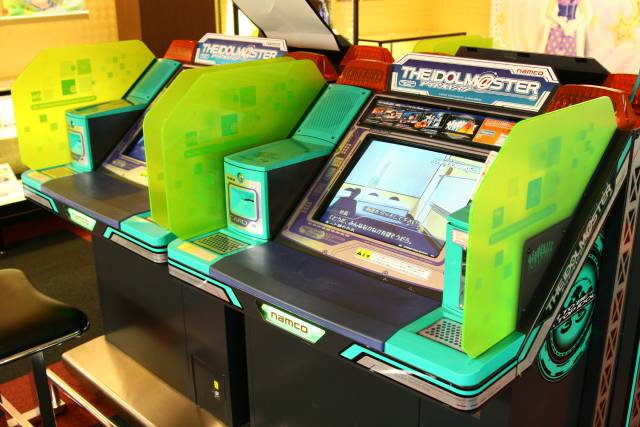
The arcade machine would appear in Japanese salons on July 26, 2005 and would include tactical controls to facilitate entering commands and accepting between different dialogue options. For its part, progress would be stored in two different cards, firstly the producer card that would record the number of units created and managed as well as the rank obtained in the game, and secondly the idol card, which would contain the stats of the same and the photographs taken during the performances. Both would be supplied by the machine when you first start playing.
The player would take the role of a rookie producer who is hired by the 765 Production agency, with the objective of managing a unit by choosing its members among the ten idols of the company, these being Haruka Amami, Chihaya Kisaragi, Yukino Hagiwara, Yayoi Takatsuki, Ritsuko Akizuki, Azusa Miura, Iori Minase, Makoto Kikuchi, and twins Ami and Mami Futami, choosing their wardrobe from three different types of outfits and the theme music to promote them, with ten tracks available corresponding to each of the game’s idols. The game would be developed through 52 weeks in which to manage the activities of the group and its members through several options that would include taking lessons to improve stats, promotional events and auditions to increase the fan base or give a day of rest, to which must be added the frequent interactions in the game that would affect the tension of the characters and their motivation when carrying out each activity. Throughout this period of time, if the player did not achieve the goal set, the group would hold a farewell concert for the group to later disband and start the game from the beginning.

Each of the girls would have different levels in the Vocal, Visual and Dance parameters, each of them standing out in one of these aspects and with which they would have to be played to form a balanced unit. The lessons would help to improve the levels of one or several parameters through various minigames in which a certain skill would be required, having a greater effect on some specific parameters each week. The auditions, for their part, would make the group created by the player face those of other players through the online functions of the machine, having to attract the attention of the judges using the options of each parameter to earn points in each section and later use the memories (Omoid) with which to get a better impression to be able to win positions in each of the three phases of this event, after which the idol would go on to perform her performance while the player could draw photos alternating between different frames and using Appeal’s ability to make an impact on the public. At the end of the day, a summary of the progress would be made and the group would increase its fan base, as well as the idol rank.
The success of the arcade version opened the door to adapt the franchise to the home console market. Yôzô Sakagami, producer of the franchise, was not sure that the series could be adapted to that market due to technical limitations and online infrastructure but considered that Microsoft’s Xbox 360, which was already on the market at that time, would be the ideal machine to meet the specifications of the game thanks to both its power and the Xbox Live online gaming network. This adaptation would begin in early 2006, reaching the market at the beginning of the following year. The mechanics of the game would be adapted to the controls of the console while other options, such as the idol and producer data, would use on the one hand the player’s gamertag and on the other a memory unit for storage, adding in turn the option to face rival idol groups of other players while connected to the Xbox Live service.
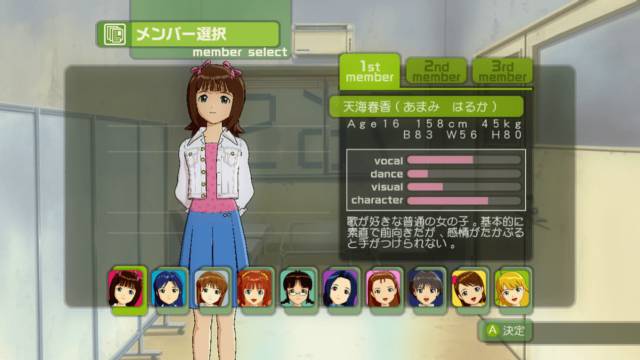
In the technical section, the console allowed developers to improve the polygonal loading of the models, offering a remarkable and much more refined image change compared to the arcade version, which in turn would serve as an incentive for those players who had not tested the machine they had the perfect opportunity to play for the first time. On the other hand, the character designs for this version had to be redone from scratch, adding new details that improved the overall quality of the set and offering an aspect closer to the anime style. The choreographies for each song, which in the original used motion captures by real artists, also had to be redone, recording the movements again.
As a novelty in this version, six new songs would be included along with a new character, Miki Hoshii, while the time limit would be eliminated, being able to take a much slower and less stressful pace, and including special events called Idol Dramas, and new costumes through DLC content. This title did a great deal to increase the proportion of Xbox Live subscriptions and consoles sold in Japan, while four times as many point cards were sold on launch day than other titles.

Later, the game would be adapted to PlayStation Portable under the title The Idolmaster SP in three different versions (Perfect Sun, Missing Moon and Wandering Star), each of which had three characters to produce (in the case of Ami and Mami, they would both be together) and introducing a rival agency, 961 Production, which would include Miki Hoshii, Hibiki Ganaha and Takane Shijou as part of what would be called Project Fairy. This version would offer a more modest technical section, taking into account the differences in power between the Sony laptop and the Microsoft desktop console, however the development team was satisfied with the result, especially with the expressions of the characters, the which had to be redesigned when adapting the game.
The production mode would offer a wide number of scenes across each of the ranks, which would be gained through the improvement of the idols and their success in gaining fans through auditions. The absence of online options to compete with other player units was solved through the creation of the rival production company that would be the main competition in the game’s story mode, thus producing a strengthening with this action in the relationship between the player and the idol produced during the match through this confrontation. To produce this, one of the characters from 765 Production was chosen to be part of 961 Pro, finally Miki Hoshii being chosen for this task due to their unpredictable nature, while Hibiki and Takane, who were thought to be part of the team of the arcade machine, they were introduced as characters from this series of games.
The gameplay would follow the same guidelines as the Xbox 360 version with the exception that this time the idols would be managed alone unlike the previous ones where duos or trios could be formed. New game options would also be added, including free mode that allowed you to play the title in a similar way to the arcade machine through the 52-week period or Office mode in which you can choose any of the idols and play your lines of dialogue or set up your costumes and song to audition alongside other players using ad-hoc play options. The progress could be alternated between the three versions, passing the data between each one of them, which would allow, although in a spectacular way, to produce all the girls.
2nd VISION

The series would enter a new stage with this name that, although it would continue to offer the same playability of previous games, would serve to increase the cast of characters through the new titles, some of them as rivals as in the case of the male group Jupiter, and others from different companies, as would be the case with the first title of this line, The Idolmaster: Dearly Stars for Nintendo DS. The title of the Nintendo laptop would appear at the end of 2009 in Japan and would follow a similar style to the previous games, although in this case taking the perspective of one of the three aspiring idol girls between Ai Hidaka, Eri Mizutani and Ryo Akizuki, The latter being the nephew of Ritsuko Akizuki, who joined the 876 Production agency, having in turn independent stories that would develop through the game.
After choosing between one of them, the game would develop through a daily preview in which to hold lessons and promotional events, some of which will be mandatory to advance in the game’s history. At the beginning of each week, you will be able to interact with the other two idols while seeing the progress made and also receiving advice, as well as being able to make changes to the costumes and songs, which cannot be altered at the beginning of the following week. Once certain events have been completed, you can participate in an audition, the success of which will depend on the parameters and popularity of the idol, following a similar scheme to that of the first game in the series and affecting the development of the story. Once the story of one of the characters has been completed, you can continue playing with the other two and by completing all the episodes of each character with the true ending of each one, the epilogue of the same will be unlocked.

The game would make use of the tactile characteristics of the Nintendo DS to include some curious options. Among them is the option of configuring an original choreography for live performances by taking movements from previous ones, being able to get new movements by completing lessons successfully. On the other hand, the camera angles could also be configured in such a way that they could be assigned to the phrases of each song. These settings would have an impact on the character’s image level. Another feature would be a mini-game of rhythms during the performances that would serve to animate the idol, previously choosing different songs and claps to use to achieve a greater effect. Additionally, a wireless mode based on this aspect would be included that would allow to compete with up to 16 players. Finally, there is a special option that allowed the idol to be equipped with a t-shirt which could be personalized with different designs or phrases by drawing with the stylus or using clipart from the game itself.
The next game would be The Idolmaster 2, a sequel to the original game that would be presented in 2010 during the franchise’s fifth anniversary concert, considering it as the cornerstone of the new stage. The game would arrive in the first instance on Xbox 360 later adapting for PlayStation 3 in a dislike that would include part of the DLC that appeared on Microsoft’s console along with new content and various adjustments. The plot would take place half a year after the debut of the girls and 765 Pro suffering from the lack of success in their productions, with the exception of the group Ryuugu Komachi, a unit formed by Iori Minase, Azusa Miura and Ami Futami and whose production Ritsuko Akizuki leads. who has left her idol career behind to become a producer. Due to this, the rest of the girls have not managed to attract the public with their solo careers, so the president of the company, Junjiro Takagi, leaves it up to the Producer to create another successful unit for the company to win the award. Idol Academy title. On his way he will cross 961 Pro, the rival company of Takao Kuroi, who thanks to his new secret weapon, the male idol group Jupiter, intends to defeat Takagi and his company.

The game engine would be updated for this new installment, which would result in improved graphics in the modeling of characters and scenarios, the latter having mobile elements. In turn, the characters underwent some design changes that resulted in a more refined and better finished appearance, while the characters of Hibiki Ganaha and Takane Shijou, previously presented in The Idolmaster SP as rivals and who would be added to the selection roster. now they would be part of the 765 Pro squad, ignoring the events of that title. The game would lack online PvP features, largely removed due to the results of a survey where players enjoyed the interactions with the characters more than the online aspect, this time offering the confrontation in festivals against other rival units, including Ryuugu Komachi and Jupiter. at certain moments of the game, which would serve as an incentive and challenge when playing.
The development of the game focuses on choosing the three members of the new unit, selecting them from among the nine available girls, and managing their activities through a period of 55 weeks in which the main objective is to win all five Idol Academy festivals, which are unlocked by accumulating a total of more than one hundred thousand fans in certain areas, facing rival groups, made up of the non-selected members, that will complicate the premise. In turn, it would be necessary to meet as an extra requirement to introduce a single in the Top 10 of the Dotop TV music channel, which reviews each week the progress in sales of musical themes, having to play with several variables to be able to fulfill it or in failing that, participate in a consolation event.
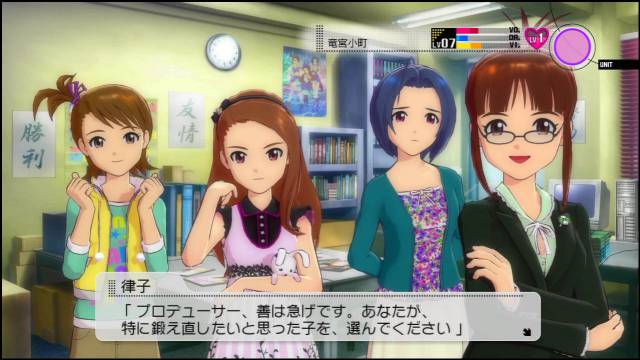
The relationships between the producer and the members of the group would also have a certain importance in the game through not only the events of each of them in the promotions but also through interactions in the form of small questions and mini-games that would serve to improve the level of conjunction of the group, making the level of the unit, which would be shown in the upper right part of the screen with a colored circle, to increase. The leader of the group would be the main character of the story, showing her background and also the evolution of the relationship between her and the producer through events that would take place at certain moments of the game.
The changes introduced in this new installment affect some elements such as the suits, whose name was simplified, or the lessons, which in this case are reduced to three types, one for each parameter, and also their execution, simplifying the mechanics so that They will not be complicated to complete and get better grades more easily. In concerts and auditions, the gameplay would offer a rhythm game system in which, unlike the original game, where it was simply limited to pressing a button to increase the score in each parameter, in this case it changes to a system where the timing is the key, having to press each button, assigned to each of the three parameters (Visual, Dance and Vocal), following the rhythm of the music, in such a way that the total score would increase, at the same time the same would happen with the positions for the auditions (being necessary to reach the first positions) or the level of public mood (or hakoyure as it is named in the game), having to exchange buttons each time to maintain the score level since with each press the levels of each parameter decrease while increasing in others. In turn, the use of Appeal is facilitated, limiting to pressing the X button on the controller (A on Xbox 360), needing to have a sufficient level of memories to be able to execute it, and the Burst Appeal movement is introduced, a technique that requires filling the Voltage bar located under the total score and that when it reaches the maximum allows to execute it with R1 producing a drastic increase in the score obtained with each press temporarily. Among the novelties would be the power to equip, apart from the costumes and accessories, different types of amulets with varied effects that would facilitate in a certain way the victories in the different musical events, having a total of 47 types (an extra one through winning a festival secret of great difficulty), each one respecting a prefecture of Japan, which can be obtained by completing festivals and concerts successfully, being necessary to have enough money to be able to acquire them later. Another novelty would be the integration of the Sing 4 You mode, which takes the basis of the spin off game The Idolmaster: Live for You to be able to configure both the group, its members, its costumes and accessories, theme and stage to create a personalized performance each time.
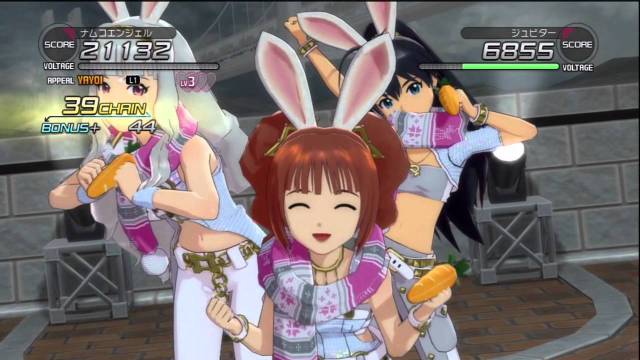
The differences between the Xbox 360 and PS3 versions would affect the content of the game, the latter having some new features such as the Hard difficulty mode, which would affect not only the difficulty of the game but also the costumes and songs of the rivals along the way. throughout the game, and some gameplay adjustments. On the other hand, it would include costumes and songs as standard, part of them from the first three downloadable content packages, as well as new charms and also new options for the Sing 4 You mode, including the option to choose the members of Jupiter and also to other extra characters, such as the protagonists of Dearly Stars and also to Hatsune Miku, although in the latter two cases only when buying the respective DLC content packs. Finally, an extra episode was included that focuses on the members of Ryuugu Komachi, in this case taking on the role of Ritsuko’s assistant at the same time that you can choose between her, Azusa, Iori and Ami to develop the story, each having them their own ending, while participating in different concerts.
The next game in the franchise would be The Idolmaster: One For All that would appear on sale in 2014, this time being a title designed exclusively for PlayStation 3. The differences with the previous title would be noticeable in a much less rigorous gameplay in its development by eliminating the time limit, offering in this case a development focused on seasonal seasons, and reducing the interactions and minigames to events of their own for each of the idols. For its part, the game’s setting takes some aspects of the animated series, especially taking part of the action in the office of 765 Pro and offering sequences with the game engine when advancing between weeks and also to liven up the menus with the characters of the series, including some in which Kotori Otonashi, the company’s secretary, also appears.
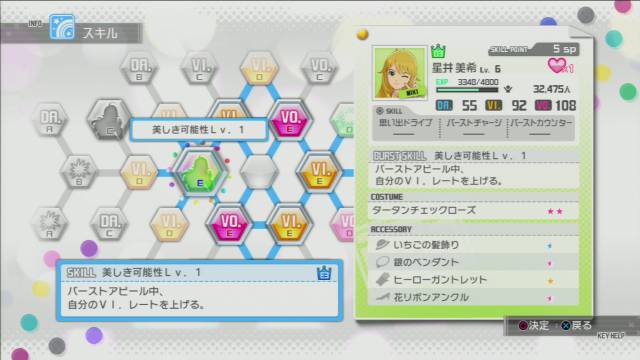
On this occasion, the game allows, for the first time, to choose between the thirteen idols of 765 Pro to manage them and gradually turn them into first-class idols, or more specifically in this game into Extreme Idols at the level of Leon, the new idol that He is part of the 961 Pro staff. From the outset he will choose both the leader of the future unit, as well as the musical theme that he will interpret and, later, the two remaining members that will make up the initial trio to follow the scheme of activities of previous games, with the novelty in this case that each member will gain experience and points, by leveling up or ranking, to invest in a skill board that will help improve both the parameters and the appeal skills and also the Burst technique of the character, being necessary in certain cases a certain amount of points and, in turn, reach a specific rank to be able to unlock them. For their part, the lessons would have certain changes in their execution, such as the introduction of commands when selecting the dance ones, offering a skill improvement for a limited time. The festivals on this occasion offer confrontations not against units of other idols of the company but against guests of other games such as Million Live or Cinderella Girls, while also including the members of Jupiter as rivals once again.
Another novelty would be the different objectives for each season that Takagi would propose to the producer, having to fulfill each one of them to be able to increase their rank each time and access the production of new members of 765 Pro and choose other musical themes. In the last week of the summer and winter seasons, the All Star Live events would be held in which all the idols would participate together in different formations to exceed the established score to be able to successfully complete the event.

The series would make the leap to the new generation of consoles with The Idolmaster: Platinum Stars, a title that would appear exclusively for PlayStation 4, offering in this case a significant improvement in terms of graphic quality as well as a redesign of the characters, more stylized and detailed with respect to the previous titles, although preserving its own characteristics such as its gestures and personality. This time a different version of the series is offered, with the 765 Pro girls having debuted as idols but without achieving definitive success. To overcome this barrier, the girls are summoned to carry out a training regimen in which they will be in the hands of a new producer who will be in charge of managing their progress through different activities with the objective of climbing through the different ranking levels to become Top Idols while doing All Star Live events together.
The gameplay would follow the guidelines of One For All having complete freedom to plan the management activities of each idol while carrying out the All Star Live events every 12 weeks. The main difference would be in the introduction of several playable mechanics that would make the game more accessible compared to previous installments. At the beginning the concerts would mark two scores as objective, a basic one to pass the event in a normal way and another EX in which some additional rewards could be obtained, such as new costumes, accessories, reinforcement objects and tickets of different categories. The game system in these phases becomes a common rhythm game in which you press the sequences of buttons that appear on the screen to increase the chain of combos and the score, using the techniques of Omoide and Burst in between during the performance.
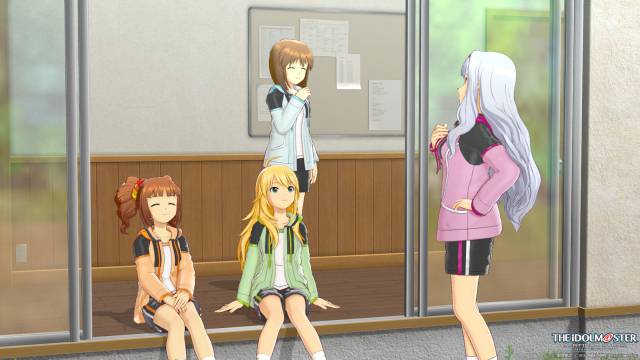
The game would make use of the functions of the Dualshock 4, including the touch button to give encouragement in previous performances and in some commands for the concerts and the gyroscope for the promotional events, in which the selection of answers is left behind to achieve communication. perfect to go on to throw a series of dice, corresponding to the affinity level of each idol, and get an initial score that can be altered by moving the dice on the producer’s agenda until obtaining the necessary to overcome it. Finally, depending on the idol selected, the light on the remote would change to the color assigned to each of them.
To overcome the concerts, the coordination of the costumes should also be taken into account when acting. Each suit apart from its image category (in this installment called Cute, Cool, Clever and Cosmic) would also have a specific type assigned (these being KiraKira Girl, Idol, Shining Star or Cheerful Girl) that would have to coincide with the one of the concert to Higher score when pressing button sequences. Failure to prepare it properly would be more difficult to achieve the necessary score and the event would have to be repeated or withdrawn from it. To this is added that the coordination elements now have their own rank and level, being able to increase their level by combining them with other accessories with the same characteristics. In some cases it is possible that these elements include special abilities such as increasing the fan rate, money, greater Appeal effect, executing a Burst with two or three characters, etc. accumulating when equipping them and being of great help in each of the musical events. Likewise, each musical theme would increase its level as it was used in the performances.
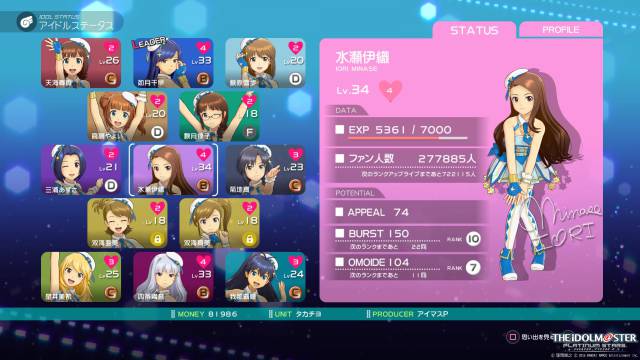
The suits would not normally be purchased through fashion stores, but in this case it would be necessary to collect the aforementioned tickets (bronze, silver and gold) to be able to manufacture designs for each of the categories. In certain cases they could be obtained as a rare gift, like accessories provided by fans. On the other hand, there would be the DL Live, which are special concerts of various types in which, apart, large amounts of money, fans and experience could be obtained by completing them, but it is necessary to have costumes with extra categories, very rare to get except when having novices high enough to get a suitable score, and have a suitable group to be able to overcome them with ease. In some of them it would be possible to get the aforementioned outfits with extra categories and in addition to special accessories, all of them of high rank, having to overcome several phases to complete them, increasing the normal and EX score requirements each time.
The lessons undergo some adjustments in this installment, keeping the visual type, now called Expression, and adding two new types, Burst and Cosmetic, the first being a minigame of pressing the button sequences as they appear on the panels and the second a game to memorize and find the elements that the coach asks for each time. At a higher level, they will have a greater effect but in turn they will also be more complicated and their cost in money will also be higher. Cada una de estas lecciones afectará a su vez a los tres parámetros de potencial de cada idol, siendo estos Appeal, que afecta a la puntuación obtenida con cada botón pulsado en secuencia en cada concierto y que aumenta progresivamente al subir de nivel, Burst, la técnica especial que aumenta la puntuación en la recta final de cada canción, y Omoide, la cual se activa con cada pulsación del botón X marcada en pantalla.
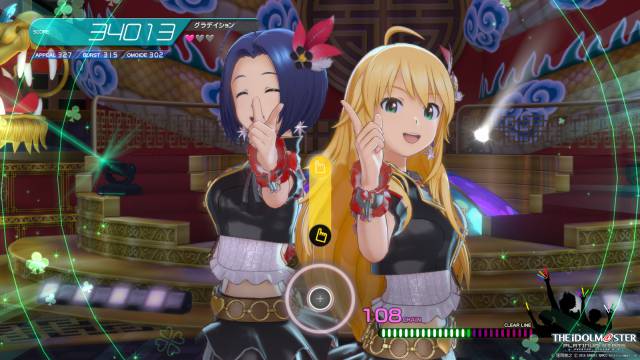
Para aumentar el rango las idol deberán acumular primeramente una cantidad de fans concreta y tras ello participar en un concierto en vivo en el actuar con tres temas musicales con los que conseguir la puntuación marcada de forma normal o con la modalidad EX. Tras superar cada fase habrá un evento conversacional con el productor, en los cuales se irá desarrollando el trasfondo personal de cada chica al tiempo que profundizando en la relación con el productor. Aunque hay momentos en los que seleccionar respuestas o de interacción, el resultado no afecta negativamente al progreso del juego. Por su parte el desarrollo del productor en este caso no implica cumplir objetivos pero si acumular una serie de puntos con los que ir aumentando progresivamente la experiencia como productor al final de cada jornada, teniendo como recompensa por cada subida de nivel el poder contar con una de las idols de 765 Pro en el plantel para producir y un nuevo tema musical que utilizar en los conciertos.
Finalmente, los menús se ven aderezados nuevamente con secuencias con el motor del juego mostrando a los personajes realizando diferentes actividades o dejando entrever parte de su personalidad, al tiempo que en cierttas ocasiones se mostrará al grupo felicitando el cumpleaños de cada uno de sus miembros, algo que ya se incluía en One For All pero de forma más escueta a través de la pizarra de la oficina.
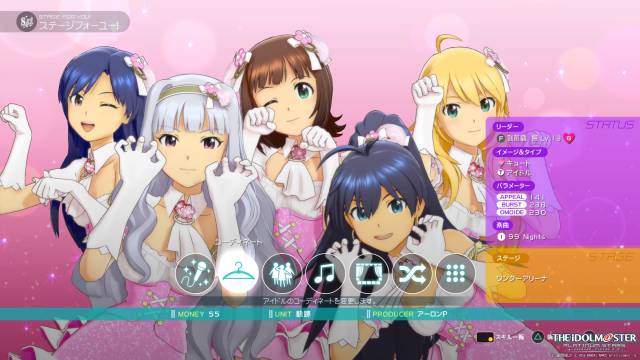
El último juego aparecido hasta la fecha es The Idolmaster: Stella Stage, que vería la luz en el mercado japonés en diciembre de 2017, y retomaría algunos aspectos de anteriores entregas, regresando a la oficina original de 765 Pro como escenario donde decidir el devenir del juego al tiempo que también se recuperaba la rivalidad con 961 Pro, que en este caso presenta a una nueva idol, Shika, para competir con la compañía de Takagi.
La base es la misma que en Platinum Stars pero ofreciendo algunos rediseños en los menús y en el desarrollo del juego, escogiendo una idol inicial entre las trece de la lista para posteriormente contar con el resto de componentes e ir alternando sus miembros como líder y para crear nuevas unidades de conjunto. Por otro lado se recuperaba el sistema de tablero de habilidades sólo que en este caso, a diferencia de One For All, el jugador podrá mover a cada una de las chicas seleccionadas a través del mismo gastando los puntos ganados (CP) para activar cada una de las casillas y conseguir mejoras de habilidad y parámetros. Por su parte, la lista de temas ofrecida en este título sería amplia, incluyendo algunos del anterior juego junto con otros de anteriores entregas hasta conformar un total de 40 pistas seleccionables, aunque desbloqueables conforme se avanza en la partida, al tiempo que también se incluye compatibilidad con el contenido DLC de Platinum Stars.
SPIN OFFS
Aparte de los juegos de la saga principal, la serie ha contado con varios títulos secundarios que han explorado diferentes mecánicas y jugabilidad que tanto han inspirado a posteriores entregas como ofrecido otros géneros al margen de la factura habitual de la serie. El primero de ellos sería The Idolmaster Live For You para Xbox 360, en el cual el jugador pasaría a tomar el rol de un representante de los fans del grupo de idols de 765 Pro, teniendo que coordinar los diferentes aspectos de las actuaciones, eligiendo los miembros del grupo, vestuario, canciones y escenario, para posteriormente coordinar los ánimos de los fans, lo cual se realiza a través de un sistema de juego de ritmos donde cada botón equivale a una acción de ánimo que aumentará el marcador de puntos y la barra de voltaje, denotada por una silueta formada por fans. Si se completan los temas con un alto porcentaje, se desbloquearía una versión remezclada de cada uno de ellos. Como nota curiosa, tanto este título como el juego original se vendieron en su versión Platinum Collection en un solo pack llamado The Idolmaster Twins.
Otro de los títulos spin offs aparecidos son las entregas de la serie Gravure For You! que se distribuyeron en diferentes packs acompañados por las ediciones en Blu Ray de cada uno de los volúmenes de suss respectivas series animadas, The Idolmaster y The Idolmaster Cinderella Girls. Estos juegos ofrecían la posibilidad de realizar sesiones de fotos con los miembros de 765 Pro y parte del elenco de 346 Pro, nueve miembros en este caso, escogiendo diferentes poses, gestos y otras configuraciones varias a la par que personalizar las opciones de imagen al sacar instantáneas, que se guardarían en el disco duro de PlayStation 3, al tiempo que se podrían escuchar temas propios de cada una de las respectivas series, en el caso de la serie principal contando con medleys de temas de cada una de las idols que protagonizan cada juego.
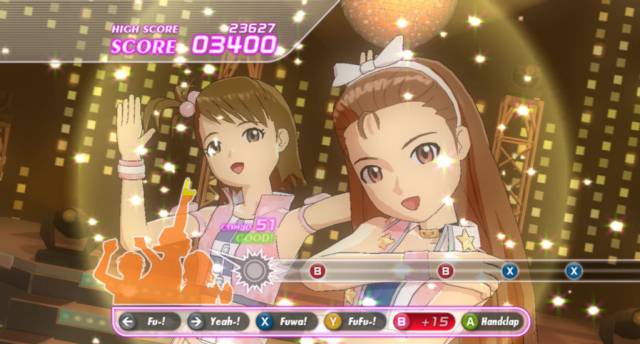
Cada volumen contaría con diferentes vestuarios que abarcarían desde bañadores a trajes escolares, pijamas, ropa de calle, kimonos e incluso trajes de actuación, como es el caso del conjunto My Dear Vampire utilizado para las actuaciones del tema musical Kyun! Vampire Girl, incluyendo en cada volumen, con excepción del primero, dos trajes para elegir. Por su parte los volúmenes de Cinderella Girls incluían tres sets de trajes al tiempo que la posibilidad de realizar fotos con miembros a la vez y también seleccionando opciones de photo booth en un estudio fotográfico. Como nota curiosa, la totalidad de los volúmenes de Gravure For You! con los miembros de 765 Pro se podían conseguir a través de la aplicación IM@S Channel, disponible a través de la PSN Store japonesa.
Para PlayStation Portable aparecería The Idolmaster Shiny Festa, un juego de ritmos que, al igual que en su momento con los juegos de The Idolmaster SP, dividiría a los miembros de 765 Pro en tres títulos (Funky Note, Honey Sound y Groovy Tune) y ofreciendo temas musicales diferentes para cada versión, los cuales mostrarían videos renderizados con el motor gráfico de las versiones de los juegos de sobremesa junto con otros que tendrían secuencias collages de secuencias de la serie animada para cada personaje, pudiendo intercalar entre ellos a la hora de jugar realizando una acción específica. Destacar que cada volumen incluiría una OVA animada entre las opciones del juego que darían protagonismo a las idols correspondientes a la versión elegida. Estos títulos verían la luz en occidente a través de la App Store de iPhone en abril de 2013, donde estuvieron disponibles hasta el cese del servicio, que tuvo lugar en 2016.

Finalmente quedan los dos títulos de ritmos en colaboración con la franquicia Taiko no Tatsujin, llamados The Idolmaster Must Songs, en los que básicamente se incluyen canciones aparecidas tanto en los diferentes juegos como en álbumes recopilatorios y series animadas, tomando como base la jugabilidad de la saga de tambores de Bandai Namco e incluyendo a los personajes regulares de la serie principal con el característico estilo de esta franquicia musical. El último título de esta categoría es The Idolmaster Cinderella Girls Viewing Revolution, título desarrollado específicamente para PlayStation VR en el que ver actuaciones de los miembros de 346 Pro al tiempo que el jugador puede utilizar los mandos Move para configurar el color de los lápices de luz y su cantidad al tiempo que los estilos de muñequeras que llevar durante la actuación.
TÍTULOS PARA MÓVILES
Al igual que otras franquicias y series con cierta popularidad, The Idolmaster ha contado con sucesivas adaptaciones para móviles en los últimos años, siendo en su mayoría títulos gratuitos enfocados a una jugabilidad de ritmos. Cada uno de ellos se centra en diferentes agencias de producción en las que habrá un amplio plantel de personajes para elegir, especialmente a través de las mecánicas de gatcha, con las que formar grupos musicales y llevarlos al éxito a través de realizar conciertos y siguiendo el desarrollo de la historia a través de cada personaje o arcos argumentales.
Entre ellos se encuentra The Idolmaster Cinderella Girls: Starlight Stage, versión mejorada del título original de 2011 el cual que se adaptaría a la versión animada emitida en el país nipón cuatro años más tarde, en el que en el papel de un productor novato que entra a trabajar para 346 Pro, eligiendo entre tres chicas iniciales entre Uzuki Shimamura, Rin Shibuya y Mio Honda y posteriormente gestionar su camino al éxito a través de eventos de historia, conociendo al resto del elenco de la compañía en el proceso y sus historias personales. Los conciertos permitirían elegir entre un apartado gráfico con modelados 2D estáticos o con modelos en 3D.
Otro de los títulos de esta categoría es The Idolmaster Million Live: Theater Days que, al igual que el caso anterior, es una versión mejorada del Million Live original que apareció en 2013 y estuvo activo los siguientes cinco años hasta el cese de su servicio en 2018, pasando buena parte del contenido y actualizaciones a esta nueva versión. En este caso el juego prosigue la historia de 765 Pro, que tras haber alcanzado el éxito con las 13 idols originales, expande su plantel añadiendo 39 nuevas chicas a lo que se llamará Project Thank You.
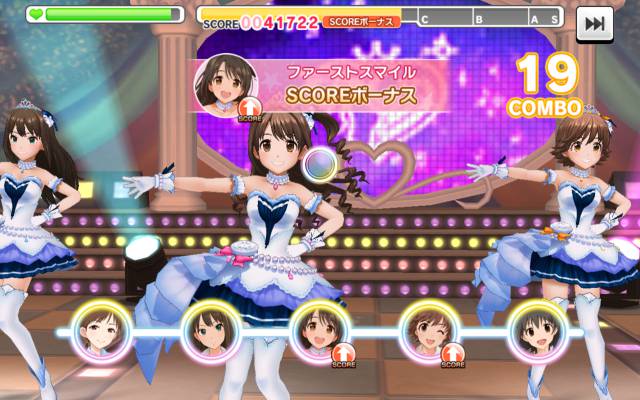
Igualmente, en este juego se da a elegir entre tres miembros del proyecto, siendo estas Kana Yakubi, Shizuka Mogami y Konomi Baba, y del que proseguir su evolución a lo largo de varios eventos del modo historia combinando con fases de conciertos en los que interpretar temas variados. Este título también ofrece una amplia interacción con los personajes, pudiendo visitar varias localizaciones y hablar con cada personaje que se encuentre o aparezca en cada una de las estancias de las oficinas de 765 Pro.
En otra instancia está The Idolmaster Side M: Live on Stage, que al igual que los anteriores casos tuvo una versión inicial lanzada en 2015 en la que se basaría el anime del mismo nombre emitido en 2017, siendo en este caso un juego que cambia por completo la tendencia de la serie, protagonizada usualmente por grupos de chicas, para dar paso a un título dedicado completamente a grupos masculinos a través en un título claramente dirigido enfocado hacia el público femenino. En este caso los jugadores pasan a ser managers de 315 Production, teniendo que entrenar a diferentes grupos de cantantes masculinos para llevarlos al éxito, encontrándose entre ellos Jupiter, rivales en la historia de The Idolmaster 2.
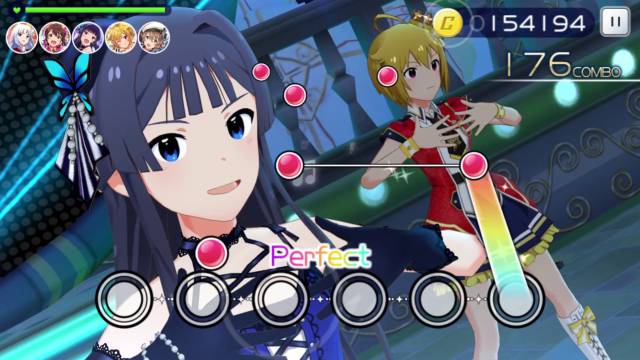
Finalmente queda el juego más reciente de la franquicia, The Idolmaster: Shiny Colors, que apareció en plataformas móviles el año, ofreciendo en este caso un estilo de juego más cercano a las versiones de consolas de la serie a través de lecciones, audiciones y partes de corte visual novel para el desarrollo de la trama. En este caso, el jugador formará parte de 283 Productions, teniendo que gestionar un total de 23 idols divididos en seis grupos musicales.
EL FUTURO
Por el momento queda para el futuro de la serie el ver como se desenvolverá el siguiente título de la serie, The Idolmaster: Starlit Season, el cual se anunció a principios de este año y que, hasta el momento, se espera su salida para finales de año, apareciendo tanto en PlayStation 4, siendo el tercer juego que verá la sobremesa de Sony en esta generación, y el primer juego que verá la luz en PC a través de la plataforma de juego Steam, de momento únicamente en territorios asiáticos y sin una confirmación de un posible lanzamiento a nivel internacional.
A su vez será el primer juego de la serie diseñado con un motor diferente, en este caso Unreal Engine 4, que, a la vista del trailer y las primeras imágenes aparecidas en la red sobre este título, ofrecerá un aspecto más detallado respecto de anteriores juegos conservando su habitual estilo anime aunque más estilizado. El elenco de personajes aumentará, ofreciendo no sólo seleccionar entre los 13 miembros de 765 Pro sino también personajes de otros juegos como Million Live, Cinderella Girls y Shiny Colors, incluyendo cinco miembros de cada uno de ellos aunque por el momento sólo confirmados tres de estas últimas series.
Por el momento no hay más datos al respecto de este nuevo título de la franquicia, especialmente debido a que la situación actual y el estado de emergencia declarado en el país nipón que afectó al evento que debería haber tenido lugar el pasado mes de abril, pero por el momento este nuevo título promete en cuanto a calidad y, a priori, da la impresión que llevará a la saga un nuevo nivel.
CURIOSIDADES
Para terminar este reportaje, comentaremos algunos aspectos, de los muchos que hay, respecto de la serie, tanto en referencia a datos de los juegos como de sus personajes y de facetas externas de los mismos.
- Los nombres de cada compañía de la serie juegan con la pronunciación de los números en japonés a través de las lecturas kunyomi y onyomi del idioma, resultando en términos curioso y apropiados para cada una de ellas. Asi pues 346 se leería Mishiro (hermoso castillo), 961 sería Kuroi (color negro), 315 como Saikô (máximo) y 283 se pronuncia Tsubasa (alas). Los nombres de 765 Pro y 876 Pro, por su parte, hacen referencia a la propia productora del juego, Bandai Namco, leyendo el primero como Namuko (Namco) y el segundo como Bannam. Curiosamente el canal oficial de Youtube de Bandai Namco en Japón se llama actualmente 876 TV.
- El proyecto Thank You de Million Live es, igualmente, un juego de palabras. En el juego lo forman 39 integrantes, de forma que al leerlo se interpreta leyendo cada número en japonés de forma independiente, dando como resultado san (3) kyu (9).
- En The Idolmaster 2 hubo cambios en el casting de voces de algunos personajes. El personaje de Yukiho Hagiwara tenía la voz en el primer juego de Yurina Hase que dejó el rol y fue sustituida posteriormente por Azumi Asakura, quien sigue prestando su voz al personaje a día de hoy. Por otro lado, ante el fallecimiento de Kan Tokamaru, quien daba voz a Junichirou Takagi, el presidente de 765 Pro en los primeros juegos, se sustituyó a su personaje por Junjiro Takagi a quien daría voz Otsuka Hochu, conocido por dar voz al personaje de Jiraiya en la serie Naruto.
- Toshiyuki Kubooka ha sido el responsable del diseño de personajes en los primeros juegos de la serie. Entre sus trabajos se encuentran el haber sido director de animación en productos como Gunbuster o Nadia: The Secret of Blue Water y diseñador de personajes en la serie Giant Robo. Aparte, también ha sido diseñador de personajes en los juegos de la franquicia Lunar.
- Entre los elementos de descarga ofrecidos para The Idolmaster: One For All se incluyó como contenido gratuito el traje Starpiece Memories, el mismo que el grupo lleva en la película The Idolmaster Movie.
- Haruka Amami es la heroina principal de la serie y en varias ocasiones, tanto en las actuaciones en los diferentes juegos como en la serie animada y la película, se erige como en la idol central del grupo y líder del mismo. Desde pequeña ha sido su sueño convertirse en una idol tras ver una actuación en directo y a pesar de vivir en una prefectura alejada, lo que la obliga a tomar el primer tren de la mañana para llegar a tiempo a la oficina de 765 Pro, sus ganas y empeño no decaen.
- Su característica fuerte es el canto, aunque a un nivel inferior al de Chihaya y Takane, con niveles más altos. Una de sus peculiaridades recurrentes a lo largo de los diferentes juegos es su naturaleza patosa, tropezando y cayendo al suelo en varias ocasiones. Eriko Nakamura es la actriz que da voz al personaje.
- Chihaya Kisaragi es la talentosa cantante de la compañía, teniendo el valor más alto en el stat Vocal (estando al máximo en The Idolmaster 2), pero su carácter resulta en ocasiones reservado y distante, debido sobretodo a un suceso que afectó a su familia y que terminó por dedicarse por completo a cantar. Se lleva bien con todos los miembros, aunque especialmente con Haruka.
- Aparte de cantar, su otra afición es la fotografía, algo que se muestra tanto en Platinum Stars como en The Idolmaster Movie. Curiosamente en la canción Ohayo!! Asagohan la interpretación de Chihaya tiene cierto estilo robótico, lo que ha provocado que los fans la han apodado Mecha Chihaya. En el episodio 15 de la serie animada se parodia este aspecto. Otra de sus peculiaridades es su consciencia de su talla de pecho, lo que en ocasiones la lleva a decir “Ku…” recurrentemente, usándolo también cuando está enfadada o frustrada.
- Asami Imai es quien da voz al personaje, teniendo entre sus roles conocidos a Kurisu Makise de la serie Steins;Gate, Ikaruga en la serie Senran Kagura, Noire/Black Heart de la serie Neptunia o Tsubaki Yayoi/Izayoi de la serie BlazBlue.
- Miki Hoshii destaca principalmente en el apartado visual, poseyendo una actitud relajada y algo vaga en ciertos momentos, llegando a dormirse en la oficina e incluso bostezar. A su vez está orgullosa de su cuerpo, especialmente en su talla de pecho, y no tiene reparos en llevar trajes que revelen parte de su fisonomía. A la hora de hablar suele referirse a si misma en tercera persona.
- En el primer juego Miki tenía una versión con aspecto diferente, conocida por los fans como Awakened Miki, mostrando su cabello más corto y de color castaño. En algunos de los juegos de la serie los modelos e ilustraciones han dado a entender que en realidad este era su color natural y que se teñía de rubio, pero en los títulos posteriores este detalle se ha corregido.
- Si el nivel de afinidad con Miki llega a ser alto mientras es el personaje líder en The Idolmaster 2, empezará a llamar al productor Honey, que en inglés se utiliza como apelativo íntimo de afecto. Esto se refleja también en la segunda mitad de la serie de anime.
- Entre los kanjis del apellido de Miki se incluye el de la palabra estrella, algo muy relacionado con el personaje, especialmente al usar su Burst Appeal en The Idolmaster 2 donde se pueden ver varias estrellas en el fondo.
- Su actriz de doblaje es Akiko Hasegawa, que entre otros roles destacados cuenta con poner voz a Asagi en Disgaea 4 e Itsuki Kouno en Phantom Breaker Battle Grounds.
- Yayoi Takatsuki proviene de una familia de pocos medios, siendo la mayor de cinco hermanos. Su empeño y optimismo son sus gran virtudes como idol, pero en ocasiones habla demasiado y demuestra no ser muy inteligente. Sus ganas de ayudar a los demás la han llevado a encargarse de las labores de limpieza de su casa y también de la oficina.
- En cuestiones económicas demuestra ser muy ahorradora y no le gusta desperdiciar el dinero, sintiéndose culpable y deprimida en el caso de gastarlo mal. Tiene una buena amistad con Iori, a pesar de sus diferentes condiciones sociales, y en ocasiones le encanta realizar el gesto Hi-Touch. Mayako Nigo es quien le presta voz, teniendo como otro rol destacado el de Lilica Felchenerow en Arcana Heart 3.
- Yukiho Hagiwara es una joven tímida y con poca autoestima a la que también le asusta la presencia de hombres y perros. A pesar de estos impedimentos ha conseguido convertirse en idol pasando las audiciones de 765 Pro con buenas calificaciones. Tiene la costumbre de, en situaciones de stress muy alto, de decir que va a cavar un agujero y a enterrarse, algo que ha sido utilizado en trabajos de fans para asociar dicha frase al uso de palas, algo que se puede ver en la serie animada y en la película.
- Originalmente el nombre que tuvo en los primeros diseños era Megumi y en situaciones de gran stress se desmayaba. Fue el personaje más seleccionado en las pruebas de campo de la máquina arcade. Azumi Asakura es la actriz que actualmente da voz al personaje, quien ha dado voz a otros personajes como Laphicet en Tales of Berseria o Misaki Shokuhô en To Aru Kagaku no Railgun T.
- Iori Minase es hija de una familia adinerada, siendo su padre un representante de una corporación que tiene contactos con el presidente de 765 Pro. En el juego original Iori se mostraba educada y dulce ante personas desconocidas mientras que ante sus compañeras y el productor se mostraba temperamental y con expresiones vulgares lo que le valió el apodo de “pequeña idol diabólica”. Su diseño en el juego original era diferente, llevando una cinta con la que mantenía su pelo hacia atrás y exponiendo su frente al tiempo que su cabello era más largo.
- En uno de los eventos de promoción de The Idolmaster SP, Iori menciona el nombre de su perro, el cual es Jean Valjean. Este es, a su vez, el nombre del protagonista de la novela Los Miserables de Victor Hugo.
- Es la idol preferida de Katsuhiro Harada, director de la serie Tekken. Esto se demuestra en uno de los diseños de cartas del juego Million Live! en el que Iori aparece vestida con el traje de Lili mientras de fondo se aprecia a Harada animándola.
- Rie Kugimiya es quien ha doblado al personaje en los diferentes juegos de la serie, actriz de doblaje popular por dar voz a personajes de aspecto infantil y de personalidad tsundere. Entre sus roles más conocidos están Kagura de la serie Gintama, Louise en Zero no Tsukaima, Shana en Shakugan no Shana, Taiga Aisaka de la serie Toradora!, Alphonse Elric en Fullmetal Alchemist, Happy en Fairy Tail o Aria Holmes Kanzaki en Aria the Scarlet Ammo. En videojuegos, por su parte, ha prestado voz a personajes como Haruka Sawamura en la serie Yakuza, Rise Kujikawa en Persona 4, KeA Bannings en Zero no Kiseki y Trails of Cold Steel IV, Homiron en las dos entregas de Dragon Quest Heroes, Tart en Tears to Tiara II o Marta Lualdi en Tales of Symphonia: Dawn of the New World.
- Hibiki Ganaha es una joven procedente de Okinawa cuya principal cualidad son sus dotes de baile, siendo la que tiene el nivel más alto en el stat de Dance. Debido a su procedencia es frecuente escucharla utilizar expresiones propias del dialecto de esa región. Le encantan los animales, teniendo una amplia variedad de mascotas, incluyendo un hamster, un perro e incluso un cocodrilo.
- Su versión en el prototipo era parecida a la versión final, con la excepción de que su orígen iba a ser de Kansai. Su voz es la de la actriz de doblaje Manami Numakura que entre otros papeles relevantes tiene a Narberal Gamma de la serie Overlord, Lancelot en Sakura Wars, Saya Endo en Dagashi Kashi o Rion Kugayama en Tokyo Xanadu.
- Takane Shijou es la sofisticada y en ocasiones misteriosa chica de cabellos plateados de 765 Pro, siendo la más alta de todos los miembros. Destaca en los stats de Vocal y Visual. Originalmente, el diseño del prototipo de Takane sería un personaje de con orígen europeo, proficiente en el habla germana y entre sus habilidades el saber tocar el piano además de poseer cabello rubio en lugar de plateado. En Idolmaster SP se presentaría por primera vez como rival aunque siendo consciente de las maquinaciones del presidente Kuroi para con 765 Pro. Para las siguientes entregas Takane conservaría su halo de misterio pero con una actitud más despistada.
- Su comida preferida es el ramen, algo que se aprecia tanto en la serie animada como en Platinum Stars. Sus canciones de imagen hacen referencia a aspectos tradicionales japoneses de estética y belleza. Es el único personaje que tiene el mismo cumpleaños que su actriz de doblaje, Yumi Hara, quien tiene entre sus roles conocidos los de Yumi de la serie Senran Kagura, Albedo de la serie Overlord o Kazumi Mishima en Tekken 7.
- Makoto Kikuchi es considerada el “príncipe” entre las idol de 765 Pro debido en parte a su aspecto que la hace ser masculina y a que su padre la crío como un chico, lo que le ha hecho ganar una gran cantidad de fans femeninas. Sus habilidades destacan especialmente en el baile, donde ha conseguido destacar prácticando de forma autodidacta. A pesar de todo, su aspiración es tener un aspecto más femenino, lo que la llevó a intentar convertirse en idol.
- Pese a su imagen de chica fuerte, tiene un enorme pavor a los insectos. Se especula si su diseño puede estar basado en Makoto Kotobuki, personaje de la serie de dpeortes arcade Mach Breakers. Su actriz de doblaje es Hiromi Hirata y entre sus roles conocidos se encuentran Miyabi de la serie Senran Kagura, Mao en Disgaea 3 o Ryuto en las dos entregas de Mugen Souls.
- Azusa Miura es la idol de mayor edad del grupo y posee el estereotipo de hermana mayor que cuida al resto de miembros. Su fuerte es el atributo Visual y su motivo para convertirse en idol fue para encontrar a alguien especial. Su sentido de la orientación es pésimo y se pierde con facilidad aún con mapas y una brújula a su lado. En los primeros juegos de la serie su diseño incluía una larga melena de color que en los juegos de 2nd Vision cambió llevando desde entonces el pelo más corto. Curiosamente el color de su pelo ha ido variando en los diferentes títulos de un color azul oscuro como el de Chihaya a tener un tono más violeta.
- Chiaki Takahashi es quien da voz al personaje y ha tenido otros roles conocidos como Litchi Faye Ling en BlazBlue y a Arfoire en la serie Neptunia.
- Ami y Mami Futami son las dos gemelas de naturaleza traviesa y los miembros más jóvenes del grupo. Originalmente Ami y Mami llevana el mismo peinado, con la diferencia de que Ami se hacía un moño a su derecha y Mami a su izquierda. Aprovechando su parecido, ambas se alternaban en el escenario sin que nadie, a excepción de los miembros de 765 Pro, lo supiera. Takane Shijou es una de las pocas que descubre su secreto en su versión de The Idolmaster SP. Para The Idolmaster 2, Mami se ha dejado crecer el pelo para diferenciarse de Ami.
- Originalmente en la versión arcade, ambas aparecían jugando con consolas Game Boy Advance, detalle que en la versión de Xbox 360 fue eliminado. Asami Shimoda es la encargada de dar voz a las gemelas en la serie, quien a su vez es la voz de Rin y Len Kagamine, personajes de Vocaloid que aparecen en los diferentes juegos de Hatsune Miku Project Diva, siendo ambos también gemelos.
- Entre los momentos de carga en The Idolmaster 2 se podía llegar a ver a Ami cantando una pequeña canción para “amenizar” los tiempos de carga. En los volúmenes de los juegos de Gravure for You con los personajes de 765 Pro se incluyó como contenido extra del juego junto a trailers de promoción del juego principal.
- Ritsuko Akizuki es con diferencia el miembro más responsable del grupo, formando parte de la compañía como idol y también como productora, como se denota en The Idolmaster 2 al formar el grupo Ryuugu Komachi. Con el resto de los miembros del grupo es bastante estricta, especialmente con Ami y Mami por su naturaleza revoltosa.
- Rara vez se ha visto con el pelo suelto o sin gafas, con la excepción del Live for You donde si se equipaba con el traje de pijama mientras que en The Idolmaster SP se podía equipar un objeto que eliminaba sus lentes. Por otra parte, es el personaje que más cambios de peinado ha llevado en la serie.
- Curiosamente su traje casual se parecía bastante a los uniformes que llevan los empleados de las tiendas Lawson en Japón, lo que llevó a Bandai Namco a utilizar la como representante de los productos de la serie relacionados con esta cadena de tiendas y, a cambio, el personaje de Ritsuko se convirtió en manager honoraria.
- Naomi Wakabayashi ha sido quien ha dado voz al personaje en todas las entregas de la serie. Entre otros roles destacan Sheska en la primera adaptación animada de Fullmetal Alchemist, Kudryavka Noumi en la adaptación animada de Little Busters o Suzu en la serie Doce Reinos.
- Aunque el grupo masculino Jupiter se conoce comúnmente como el primer grupo masculino de la franquicia, en realidad no es exacto, puesto que Ryo Akizuki, uno de los personajes principales de The Idolmaster: Dearly Stars, fue el primer personaje masculino de la franquicia, aunque en su caso haciéndose pasar por una chica.
- Shouta Mitarai, el miembro más joven de Jupiter, es doblado por Yoshitsugu Matsuoka, actor de doblaje conocido principalmente por otros roles más conocidos entre los que están Kirito en la serie Sword Art Online, Bell Cranel en Danmachi, Souma Yokihira en Food Wars o Sora en la serie No Game, No Life.
- En total Idolmaster cuenta actualmente con varias temporadas de series animadas, incluyendo la serie regular, Cinderella Girls, Side M y próximamente una adaptación de Million Live. Sin embargo también existe una primera serie titulada Idolmaster Xenoglossia con la misma base pero en realidad haciendo que sus protagonistas montaran en mechas para proteger el planeta de una serie de meteoritos que amenazan con impactar contra él. La escena del episodio 15 de la serie animada regular, mencionada anteriormente, también se usa como parodia esta adaptación.
